
7 minute read
Safety Matters
for The Stockman by B. Lynn Gordon
Why you should practice safe transporting and storage of semen tanks.
Breeding season is a busy and important time for all cow/calf producers, but particularly those in the seedstock business. Many hours are dedicated to studying, researching and analyzing records to determine which sires will help advance the genetic merit of your cowherd and its offspring. Artificial insemination (AI) opens the door for accessibility to industry leading beef cattle genetics.
Because of the predominant use of AI in the seedstock sector, the transportation of cryogenic container/tanks (commonly referred to in the beef industry as “semen tanks”) frequently occurs in addition to on-site storage of the tanks at the farm or ranch. Due to this common occurrence, stockmen have a greater opportunity to become complacent in conducting the proper safety procedures associated with transporting semen tanks. When we get the call from the AI company rep to let us know the ordered semen is ready, the semen tank is put on the back seat of the crew cab pickup or in the wife’s SUV and off we go to restock it, not realizing how we are putting lives in harm’s way.
SILENT KILLER
Liquid nitrogen (LN2) is nitrogen in a liquid state. When nitrogen is converted to a liquid form, it becomes a cryogenic liquid; a liquefied gas, that must be kept at extremely low temperatures. As a result of this extremely cold environment, the most common hazard is extensive tissue damage or burns from exposure to the liquid nitrogen or the cold vapors, reports the Office of Research, Environmental Safety and Health Department at Utah State University.
All cryogenic liquids produce large amounts of gas when they vaporize. Liquid nitrogen will expand to produce 700 times the volume of gas when vaporized. This rapid and extreme expansion can lead to oxygen displacement. It takes only a small volume of liquid nitrogen evaporating in a room to result in a dangerous situation.
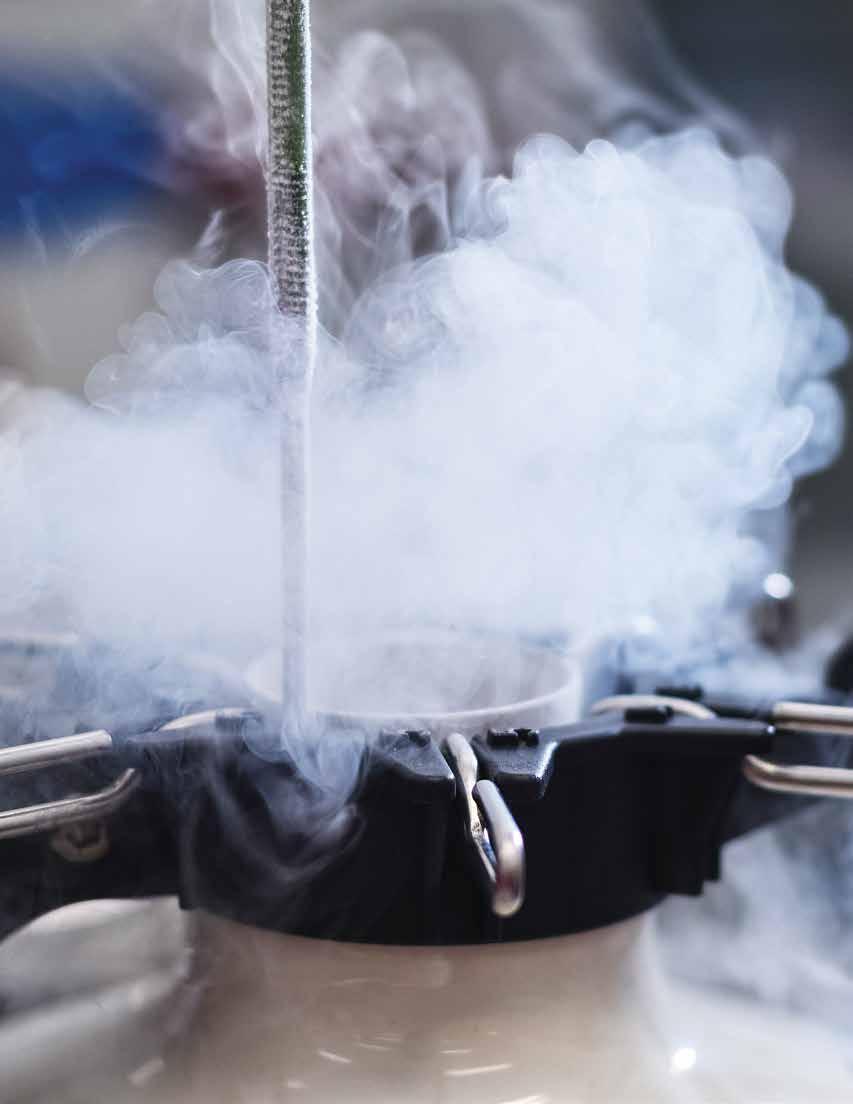
Utah State University further outlines, being odorless, colorless, tasteless, and nonirritating, nitrogen has no warning properties. Humans are unable to detect the presence of nitrogen, thus the risk as an asphyxiant when nitrogen displaces oxygen in the air to levels below that required to support life. The inhalation of nitrogen in excessive amounts can cause dizziness, nausea, vomiting, loss of consciousness, and even death. Death may result from errors in judgement, confusion, or loss of consciousness that prevents self-rescue. At low oxygen concentration, unconsciousness, and death may occur in minutes and without warning.
OXYGEN DEFICIENCY
The oxygen level in fresh-outside air is 20.9%; this is a very normal and safe environment. The National Institute for Occupational Safety and Health (NIOSH) describes 19.5% oxygen to be the onset of an oxygen-deficient environment, lower than 19.5%, people immediately begin to feel the effects. The lower the percent of oxygen in the air, the more tragic the outcome. The response by the individual may vary depending on their health, physical activity and the specific environment that they encounter.
TRANSPORTING PRECAUTIONS
ABS Global (ABS), DeForest, WI, a leading provider of beef genetics, reproduction services, and technologies, conducted several studies in 2010 to learn about the hazards of transporting liquid nitrogen semen tanks. In one study, ABS placed two newly filled tanks in the back seat of a crew cab truck. In three minutes, the cab of the pickup was unsafe for human occupancy. One hour later the level of oxygen had depleted to 14.7%. In a similar test, the tank was tipped on its side and in less than one minute the oxygen in the cab had fallen below 18.3%. Ten minutes later, the oxygen level had depleted to 9.7%.
________
-Ron Zeihen Safety Specialist, ABS Global
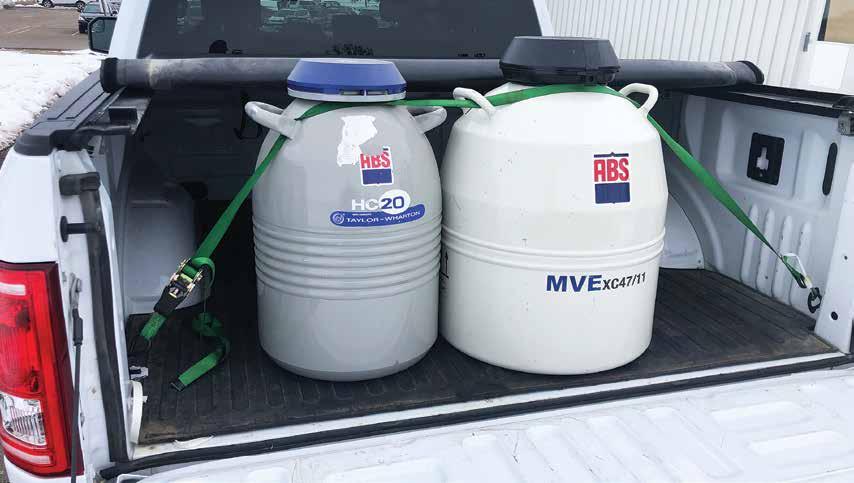
Semen tanks should only be transported securely in the bed of a truck or in a sealed compartment where no passengers are present or may enter. Photo courtesy of ABS Global.
“Proper transportation methods of the semen tanks are critical to remain safe,” says Ron Zeihen, safety specialist at ABS. Zeihen explains there is continual venting of nitrogen from the tank to prevent an explosion. In an air-tight vehicle, this release of nitrogen can be deadly. “There are just too many risks involved with hauling a semen tank inside the vehicle, rather than in the bed of the pickup truck.”
Undetected leaks, age of the tanks, and the length of time in an enclosed space all affect the risks of hauling a tank inside a vehicle. ABS does not permit any liquid nitrogen tanks inside the passenger compartment of its company vehicles.
Gerald Feikema, a 35-year semen distribution representative from Brookings, SD, was surprised to see the results of the ABS studies. He spent his entire career in the industry, and the last thing he wants to hear about is the loss of a cattleman due to lack of awareness. As he thinks about his years in the business, he says, “I know of countless people in the AI industry who travel with semen tanks in the same compartment as they are in. In fact, looking back now, I believe I have been affected by nitrogen while driving to the point of fatigue or maybe even impairment.”
STORAGE SAFETY
Because of the continual displacement of liquid nitrogen from semen tanks, caution must also be taken when storing tanks. In 2010, ABS conducted several studies at their cryogenic warehouse. They placed 10 tanks, newly filled, into a 12’ x 15’ (1440 cubic feet) enclosed, nonventilated room. The result: it took 18 minutes for the air to become unsafe for human occupancy (19.5%), and the longer the tanks sat, the oxygen level continued to slowly decrease.
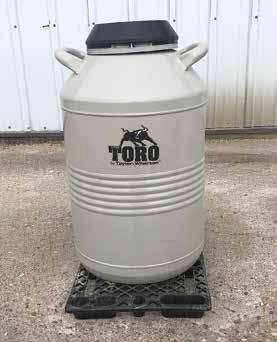
Semen tanks should be stored in a well-ventilated room with a hard surface floor, and the tank should be placed on a wood or plastic pallet. Photo courtesy of Gerald Feikema.
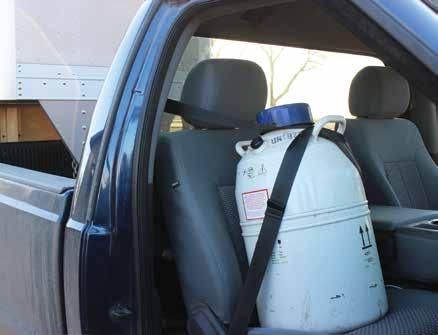
The extra space in a cab has become an easy way for cattlemen to a haul semen tanks and hold the tank in place with the seat belt. This decision can be deadly.
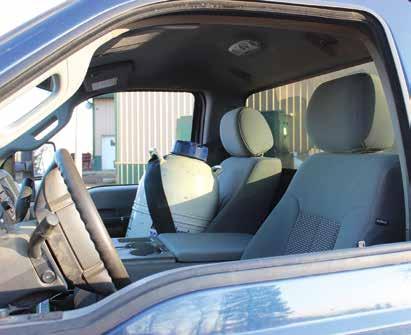
To keep the tank safe, out of the way, and out of extreme weather, producers might place the tank in a confined room or closet. Placing one or more tanks in a poorly ventilated room or closing the door behind you when you enter a room can lead to danger. “If you have tanks stored in a room or closet, make sure it is always ventilated. A pass-through air vent in the door can help keep air flow in the room,” Zeihen explains.
Tanks should be stored on a smooth, flat surface to prevent any tipping. Large tanks are heavy and cannot be easily and safely carried. Always push larger cryogenic containers, never pull and never tip or roll tanks.
CONVENIENCE IS HARMFUL
ABS conducted these studies because the company was curious about the level of oxygen depletion and because they want to make sure their employees and those in the industry are safe. Meryln Sandbulte, Beef Business Manager with ABS from Rock Valley, IA, spends the spring months hosting educational seminars in his territory. He makes sure to inform cattlemen about safety practices of transporting and storing semen tanks. He often gets looks of confusion or awe from the crowds, “It’s like I’m asking them to go on a diet,” he says. “We become such creatures of habit, and now when I’m telling them the dangers, they focus on the inconvenience of taking the extra time to load the tank in the bed of the pickup and strap it down. But which would you prefer, a few minutes to be safe or a tragedy?”
Sandbulte encourages producers to get creative and come up with a system to transport semen tanks in the bed of their pickup. In addition to using straps or ropes to secure the tank, he has used an innertube to set the tank in and has co-workers who have built a wooden box to hold the tank. Securing the tank is also important to prevent it from becoming a projectile in the event of an accident.
Overall, the three AI industry professionals agree, if you practice safety precautions, the only worry you should have this breeding season is the conception rate of your cowherd.
SAFE STORING & TRANSPORTING
>Store in an area with adequate ventilation. Never store a LN2 tank within any confined space area such as an attached garage, shed, office or barn. A tank failure or leak could lead to an excessive LN2 loss which would displace oxygen making the environment extremely dangerous. (See NIOSH chart)
>Firmly secure tanks upright to keep them from falling or being knocked over and protect them from damage.
>Ensure that you replace tank covers after each use.
>Do not store or transport tanks in any compartment of a vehicle where passengers are present or may physically enter. The carrying of tanks on passenger seats in vehicles is strictly prohibited.
RESCUE AWARENESS FROM OXYGEN DEPLETION
>When a person has suffered from lack of oxygen, they need to be moved to fresh air immediately.
>If the person is not breathing administer artificial respiration.
>If breathing is difficult, administer oxygen. Obtain immediate medical attention.
>Do not attempt to rescue an individual that has been overcome due to lack of oxygen. The rescuer then becomes the second victim.
SAFE HANDLING
>Avoid contact with skin.
>Never put anything on top of a tank.
>Always wear eye protection, protective gloves, and suitable footwear.
>Always handle in a well-ventilated area or room. >
Always store tank upright and secure.



